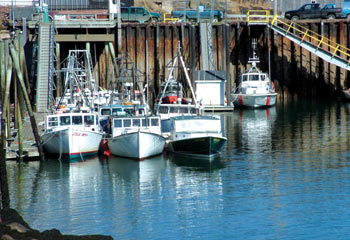Magnuson Magnified
by Laurie Schreiber
|
The reauthorization of the nation’s premier federal fisheries law, the Magnuson Stevens Fishery Conservation and Management Act (MSA), is expected to be complete this year, after a six-year delay.
On Dec. 15, 2005 the Senate Committee on Commerce, Science and Transportation unanimously approved S. 2012, an amendment to the act which takes into consideration many of the concerns brought forward by Maine’s fishing industry.
Members of the Fisheries and Coast Guard Subcommittee, which is chaired by Maine Senator Olympia Snowe and includes senators John Kerry from Massachusetts and Ted Stevens from Alaska, crafted the amendment. The bill reauthorizes the MSA from 2006 to 2012.
An amendment in the House of Representatives is on a parallel track. Once the House approves its version, the two documents must be reconciled before heading to the president for his signature.
Caps And Quotas
Total allowable catch (TAC) caps on all fishery management plan species, individual fishing quotas (IFQs), and dedicated access programs (DAPs) are key concepts in the amendment aimed at the twin goals of keeping both fish stocks and fishing communities healthy.
|

The reauthorization of the Magnuson-Stevens Act will ultimately impact most the communities dependent on the resource. The one size fits all, heavy industry model used to shape the first MSA is recognized by the designers as a failure. It’s hoped that the fishermen excluded from that earlier process will be included in this one. Photo: Fishermen's Voice |
|
|
|
|
Opium Clippers
by Mike Crowe
|
The speed of the clipper ships captured the imagination of the nation at a time when the sea was the highway and a round trip to Asia meant a year away from home. There has been more written about clipper ships than any other class. Newspaper publicity maybe be responsible for what some consider disproportionate coverage, given the many other classes. Countless hull designs have been developed over the centuries. Most took speed into consideration and whether sail or V-12 power, it’s where the wood has met the water that speed has been built in. This is just as true today for fiberglass boats.
The famed clipper ships of America and England relied on hull design for speed while the rigging varied widely. These ships first made their name as privateers in the war between America and England in 1812 and later on long ocean voyages to California, China and Australia. Their roots can be traced back to the hull designs preferred by English pirates. Smaller in size with narrow ends and lighter construction, they were more suitable for the light cargos of pirates, slavers and later, opium smugglers.
continue
|
| The clipper ship Pride of Baltimore, an authentic replica of the early clipper ships. Its maiden voyage was May, 1977. Baltimore clippers were typical of clipper schooners between 1800 and 1815. The Pride was a medium-sized topsail schooner, 90' on deck, 23' beam, 9’9" draft, and 120 tons. This 1983 photo shows the characteristic narrow hull, sharp entry and lowfree board. Photo: Greg Pease |
|
|
|
|
|
  
|
|

